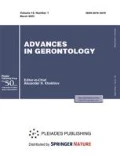Abstract
An assessment of the physical status of older women was performed based on anthropometry and bioelecytrical impedance analysis. The somatotype was determined with the use of J. Tanner’s index of sexual dimorphism (1951). In the surveyed sample, 46.15% women had a gynecomorphic body type manifested in the structural feminization of the skeletal system; masculinization of the skeletal system (andromorphism) was found in 4.74% of cases; and mild dysplasia towards the opposite sex was observed in 49.11% of older women, which corresponded to the mesomorphic somatotype. It was found that women with a gynecomorphic body type were significantly shorter than those with mesomorphic or andromorphic types; they had lower mass and transverse dimensions of the body. The largest absolute content of the fat mass and lean mass components were found in women with andromorphic body type, while the representatives of the sample with a gynecomorphic body type demonstrated the lowest values of these indicators of body composition. The results of anthropometric and bioimpedance measurements with allowance for the body type of elderly women involving J. Tanner’s index of sexual dimorphism reflect their adaptive capabilities and can serve as markers (predictors) of nonspecific somatic diseases.
Similar content being viewed by others
References
Anisimova, E.A., Lukina, G.A., and Anisimov, D.I., Age variability of total body sizes and body type of women, Byull. Med. Internet-Konf., 2014, vol. 4, no. 6, pp. 918–921.
Aryukhov, I.P., Medvedeva, N.N., Nikolaev, V.G., et al., Assessment of the health of the population, Kazan. Med. Zh., 2013, no. 4, pp. 522–526.
Bezdenezhnyi, A.V. and Sumin, A.N., Sarcopenia: distribution, detection, and clinical significance, Klin. Med., 2012, no. 10, pp. 16–23.
Bryantseva, O.V., Determination of biological age in elderly people with cardiovascular pathology, Sovrem. Probl. Nauki Obraz., 2012, no. 2.
Grigoryan, O.R. and Andreeva, E.N., Carbon metabolism in women during menopause, Sakharnyi Diabet, 2009, no. 4, pp. 15–20.
Gur’eva, A.B., Anthropometric characteristic of physical status of 36–75 years-old Caucasoid women in Sakha Republic (Yakutia), Dal’nevost. Med. Zh., 2011, no. 4, pp. 80–82.
Derevtsova, S.N., Somatometric features of body proportions of the male population of the Krasnoyarsk city, Sib. Med. Zh., 2010, no. 4–1, pp. 141–147.
Derevtsova, S.N., Somatometric features of body proportions of the female population of the Krasnoyarsk city, Sib. Med. Zh., 2011, nos. 1–1, pp. 164–169.
Nasledov, A.D., SPSS 19: professional’nyi statisticheskii analiz dannykh (SPSS 19: Professional Statistical Data Analysis), St. Petersburg: Piter, 2011.
Nikolaev, V.G., Nikolaeva N.N., Sindeeva, L.V., and Nikolaeva, L.V., Antropologicheskoe obsledovanie v klinicheskoi praktike (Anthropological Tests in Clinical Practice), Krasnoyarsk: Verso, 2007.
Nikolaev, V.G., Medvedeva, N.N., Shul’min, A.V., et al., Biophysical markers and their role in assessment of physical status of a man, Sib. Med. Obozr., 2013, no. 6 (84), pp. 30–33.
Plakuev, A.A., Yur’eva, M.Yu., and Yur’ev, Yu.Yu., Modern concepts of aging and assessment of human biological age, Ekol. Chel., 2011, no. 4, pp. 17–25.
Romanenko, A.A., Derevtsova, S.N., Petrova, M.M., et al., Use of the markers for the assessment of physical health of adolescence representatives, Sovrem. Probl. Nauki Obraz., 2015, no. 3.
Sindeeva, L.V., Petrova, M.M., and Nikolaev, V.G., Anthropometric and bioimpendance indices as the markers of physical health of women, Sovrem. Probl. Nauki Obraz., 2015, no. 5.
Sovetkina, N.V., Ar’eva, G.T., Ovsyannikova, N.A., and Ar’ev, A.L., Characteristics of somatic pathology in elderly and senile patients: a review, Usp. Gerontol., 2011, vol. 24, no. 4, pp. 438–442.
Tikhonova, N.V., Dobretsova, E.A., Turchina, Zh.E., et al., Social, psychological, and medical aspects of active longevity, Med. Pbraz. Sib., 2015, no. 3.
Frolova, E.V. and Korystina, E.M., Comprehensive assessment of the health of the elderly persons and its implementation in practice, Ross. Semeinyi Vrach, 2010, vol. 14, no. 1, pp. 12–23.
Khrisanfova, E.N. and Perevozchikov, I.V., Antropologiya (Anthropology), Moscow: Nauka, 2005.
Sharipov, K.O. and Dzhainakbaev, N.T., Biomedical and social aspects of aging and active longevity, Aktual’nye Probl. Transp. Med.: Navkol., Sered., Prof. Zdorov’ya Patol., 2014, no. 2 (1), pp. 12–27.
Yarygina, V.N. and Melent’eva, A.S., Rukovodstvo po gerontologii i geriatrii. Tom 2. Vvedenie v klinicheskuyu geriatriyu (Guide on Gerontology and Geriatrics, Vol. 2: Introduction to Clinical Geriatrics), Moscow: GEOTAR-Media, 2010.
Barzilai, N., Guarente, L., Kirkwood, T.B.L., et al., The place of genetics in ageing research, Nat. Rev. Genet., 2012, vol. 13, no. 8, pp. 589–594.
Gába, A. and Pridalová, M., Age-related changes in body composition in a sample of Czech women aged 18–89 years: a cross-sectional study, Eur. J. Nutr., 2014, vol. 53, no. 1, pp. 167–176.
Lowthian, J.A., Jolley, D.J., Curtis, A.J., et al., The challenges of population ageing: accelerating demand for emergency ambulance services by older patients, 1995–2015, Med. J. Austral., 2011, vol. 194, no. 11, pp. 574–578.
Severinsen, M.T., Kristensen, S.R., Johnsen, S.P., et al., Anthropometry, body fat, and venous thromboembolism: a Danish follow-up study, Circulation, 2009, vol. 120, pp. 1850–1857.
Sanderson, W.C. and Scherbov, S.A., New perspective on patterns of aging in Europe by education and gender, J. Popul. Ageing, 2015, pp. 1–19.
Spijker, J. and Macinnes, J., Population ageing: the timebomb that isn’t?, Br. Med. J., 2013, vol. 347, no. 7933, pp. 20–22.
Author information
Authors and Affiliations
Corresponding author
Additional information
Original Russian Text © S.N. Derevtsova, A.A. Romanenko, N.V. Tichonova, 2016, published in Uspekhi Gerontologii, 2016, Vol. 29, No. 2, pp. 337–341.
Rights and permissions
About this article
Cite this article
Derevtsova, S.N., Romanenko, A.A. & Tichonova, N.V. Making use of J. Tanner’s scale of sexual dimorphism for assessment of the physical state of older women. Adv Gerontol 6, 333–337 (2016). https://doi.org/10.1134/S2079057016040032
Published:
Issue Date:
DOI: https://doi.org/10.1134/S2079057016040032




